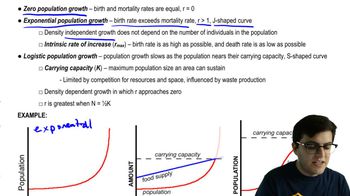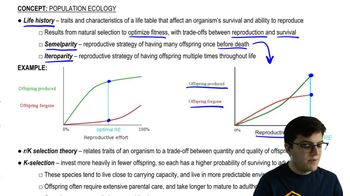Table of contents
- 1. Introduction to Biology2h 40m
- 2. Chemistry3h 40m
- 3. Water1h 26m
- 4. Biomolecules2h 23m
- 5. Cell Components2h 26m
- 6. The Membrane2h 31m
- 7. Energy and Metabolism2h 0m
- 8. Respiration2h 40m
- 9. Photosynthesis2h 49m
- 10. Cell Signaling59m
- 11. Cell Division2h 47m
- 12. Meiosis2h 0m
- 13. Mendelian Genetics4h 41m
- Introduction to Mendel's Experiments7m
- Genotype vs. Phenotype17m
- Punnett Squares13m
- Mendel's Experiments26m
- Mendel's Laws18m
- Monohybrid Crosses16m
- Test Crosses14m
- Dihybrid Crosses20m
- Punnett Square Probability26m
- Incomplete Dominance vs. Codominance20m
- Epistasis7m
- Non-Mendelian Genetics12m
- Pedigrees6m
- Autosomal Inheritance21m
- Sex-Linked Inheritance43m
- X-Inactivation9m
- 14. DNA Synthesis2h 27m
- 15. Gene Expression3h 20m
- 16. Regulation of Expression3h 31m
- Introduction to Regulation of Gene Expression13m
- Prokaryotic Gene Regulation via Operons27m
- The Lac Operon21m
- Glucose's Impact on Lac Operon25m
- The Trp Operon20m
- Review of the Lac Operon & Trp Operon11m
- Introduction to Eukaryotic Gene Regulation9m
- Eukaryotic Chromatin Modifications16m
- Eukaryotic Transcriptional Control22m
- Eukaryotic Post-Transcriptional Regulation28m
- Eukaryotic Post-Translational Regulation13m
- 17. Viruses37m
- 18. Biotechnology2h 58m
- 19. Genomics17m
- 20. Development1h 5m
- 21. Evolution3h 1m
- 22. Evolution of Populations3h 52m
- 23. Speciation1h 37m
- 24. History of Life on Earth2h 6m
- 25. Phylogeny2h 31m
- 26. Prokaryotes4h 59m
- 27. Protists1h 12m
- 28. Plants1h 22m
- 29. Fungi36m
- 30. Overview of Animals34m
- 31. Invertebrates1h 2m
- 32. Vertebrates50m
- 33. Plant Anatomy1h 3m
- 34. Vascular Plant Transport2m
- 35. Soil37m
- 36. Plant Reproduction47m
- 37. Plant Sensation and Response1h 9m
- 38. Animal Form and Function1h 19m
- 39. Digestive System10m
- 40. Circulatory System1h 57m
- 41. Immune System1h 12m
- 42. Osmoregulation and Excretion50m
- 43. Endocrine System4m
- 44. Animal Reproduction2m
- 45. Nervous System55m
- 46. Sensory Systems46m
- 47. Muscle Systems23m
- 48. Ecology3h 11m
- Introduction to Ecology20m
- Biogeography14m
- Earth's Climate Patterns50m
- Introduction to Terrestrial Biomes10m
- Terrestrial Biomes: Near Equator13m
- Terrestrial Biomes: Temperate Regions10m
- Terrestrial Biomes: Northern Regions15m
- Introduction to Aquatic Biomes27m
- Freshwater Aquatic Biomes14m
- Marine Aquatic Biomes13m
- 49. Animal Behavior28m
- 50. Population Ecology3h 41m
- Introduction to Population Ecology28m
- Population Sampling Methods23m
- Life History12m
- Population Demography17m
- Factors Limiting Population Growth14m
- Introduction to Population Growth Models22m
- Linear Population Growth6m
- Exponential Population Growth29m
- Logistic Population Growth32m
- r/K Selection10m
- The Human Population22m
- 51. Community Ecology2h 46m
- Introduction to Community Ecology2m
- Introduction to Community Interactions9m
- Community Interactions: Competition (-/-)38m
- Community Interactions: Exploitation (+/-)23m
- Community Interactions: Mutualism (+/+) & Commensalism (+/0)9m
- Community Structure35m
- Community Dynamics26m
- Geographic Impact on Communities21m
- 52. Ecosystems2h 36m
- 53. Conservation Biology24m
50. Population Ecology
Introduction to Population Ecology
Problem 7d
Textbook Question
Textbook QuestionExplain why biologists want to maintain (a) 'habitat corridors' that connect populations in a metapopulation, and (b) unoccupied habitat that is appropriate for the species in question.
 Verified step by step guidance
Verified step by step guidance1
1. Habitat corridors are important because they allow for the movement of individuals between different populations within a metapopulation. This movement, or gene flow, can help maintain genetic diversity within the metapopulation, which can increase the overall fitness and survival of the species. Without these corridors, populations can become isolated, leading to inbreeding and a decrease in genetic diversity.
2. Habitat corridors also facilitate the recolonization of habitats where local extinctions have occurred. If a population in one habitat patch goes extinct, individuals from another patch can move through the corridor to recolonize the area. This can help maintain the overall size and stability of the metapopulation.
3. Maintaining unoccupied habitats that are suitable for the species is also crucial. These habitats can act as 'refuges' or 'reserves' where the species can survive and reproduce if conditions in their current habitat become unfavorable due to factors like disease, predation, or environmental changes.
4. Unoccupied habitats can also provide opportunities for population expansion when conditions are favorable. If a population grows too large for its current habitat, individuals can disperse to the unoccupied habitat and establish a new population there.
5. In conclusion, maintaining habitat corridors and unoccupied habitats are both important strategies for conserving biodiversity and ensuring the long-term survival of species in a changing environment.
Recommended similar problem, with video answer:
 Verified Solution
Verified SolutionThis video solution was recommended by our tutors as helpful for the problem above
Video duration:
2mPlay a video:
Was this helpful?
Key Concepts
Here are the essential concepts you must grasp in order to answer the question correctly.
Metapopulation Dynamics
A metapopulation consists of multiple, spatially separated populations of the same species that interact through migration. Understanding metapopulation dynamics is crucial for biologists as it helps them assess how populations can persist over time despite habitat fragmentation. Habitat corridors facilitate gene flow and recolonization, which are essential for maintaining genetic diversity and population stability.
Recommended video:
Guided course

Disturbances Make Communities Dynamic
Habitat Corridors
Habitat corridors are strips of natural habitat that connect isolated populations, allowing for the movement of individuals between them. These corridors are vital for reducing the risks of inbreeding and local extinction by enabling species to access resources, mates, and new habitats. By maintaining these connections, biologists can enhance the resilience of populations against environmental changes.
Recommended video:
Guided course

Habitat Destruction and Degradation
Conservation of Unoccupied Habitat
Conserving unoccupied habitat is essential for species recovery and long-term survival. This habitat can serve as potential sites for population expansion or reintroduction efforts, providing safe spaces for species to thrive. By ensuring that suitable habitats are preserved, biologists can support biodiversity and help mitigate the impacts of habitat loss and climate change.
Recommended video:
Guided course

Habitat Destruction and Degradation

 1:17m
1:17mWatch next
Master Population Ecology with a bite sized video explanation from Jason Amores Sumpter
Start learningRelated Videos
Related Practice



































































